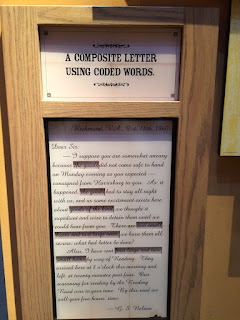I wonder how different the underground railway would be today with the availability of social media and so many forms of communication. But back in the day, when the slaves were trying to escape to Cincinnati and the North for their freedom, escapees and helpers had to rely on more clandestine methods of communication.
This part of our nation's history was on display at the National Underground Railroad Freedom Center in Cincinnati. The Freedom Center featured examples of how people communicated to assist slaves in going from one point to another. They started fires at certain points along the riverbank when someone arrived. A lantern on a pole was another symbol that the house was safe, as was a row of white bricks in the chimney or a flag in the hand of a statue in the yard. A quilt in a certain window was a sign, and others traveled with a piece of thread to indicate who could be trusted.
Members of the Railroad also communicated about potential runaways through coded letters. In this example, "the goods" refers to the slaves, and "two small boxes and two large ones" meant two children and two adults.
I worry that the new Colson Whitehead Underground Railroad book highlighted by Oprah will lead legions of people to believe that the escape route was a literal railway instead of the network that it was. The true Railroad was a tribute to the ingenuity and bravery of a great many people who valued freedom and liberty above their own safety.
Aren't you lucky that most all of your communication can be straightforward instead of encoded. Pause for a moment today and be grateful for the gift you have of open communication. In this season of election vitriol, the silver lining is that we live in a country where we can freely express opposing views and we don't need to go underground to do so.
-- beth triplett
leadershipdots.blogspot.com
@leadershipdots
leadershipdots@gmail.com

No comments:
Post a Comment